#mariano taibo
Explore tagged Tumblr posts
Text

Mariano Taibo - Blade Runner
30 notes
·
View notes
Text
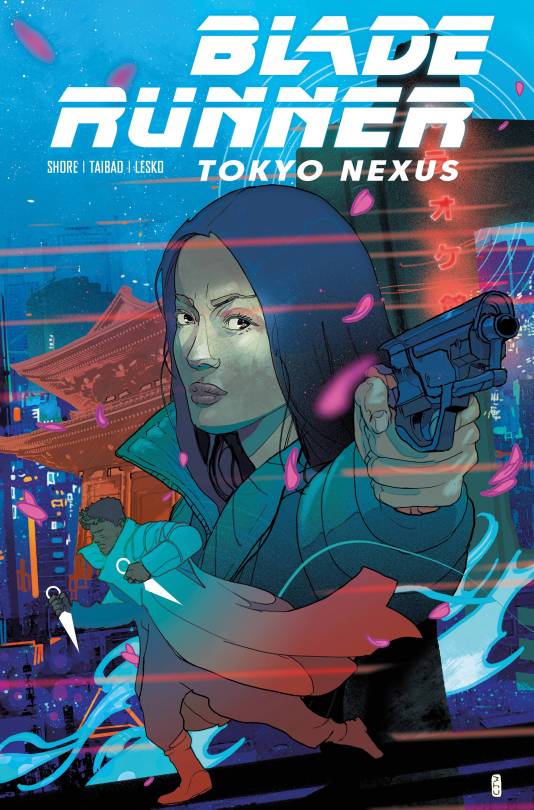
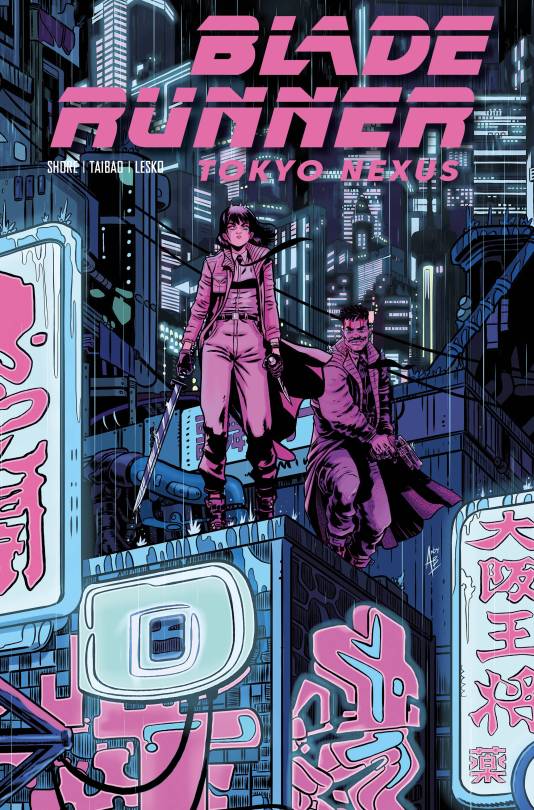
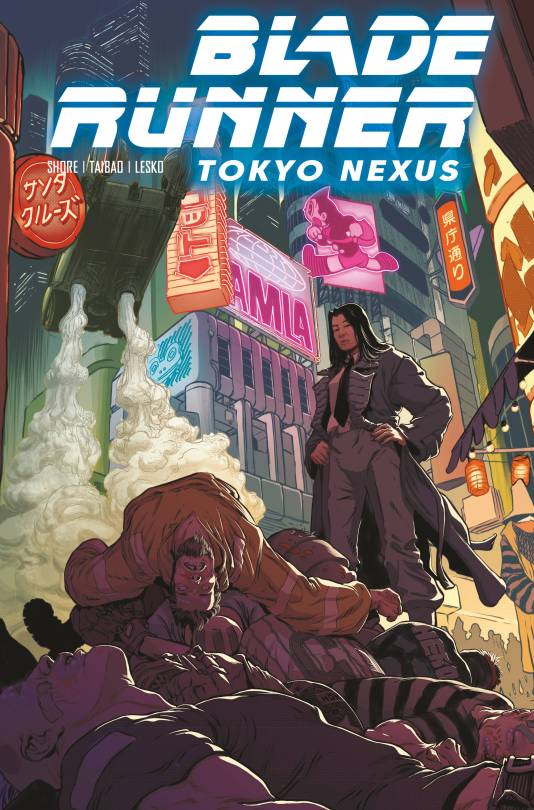
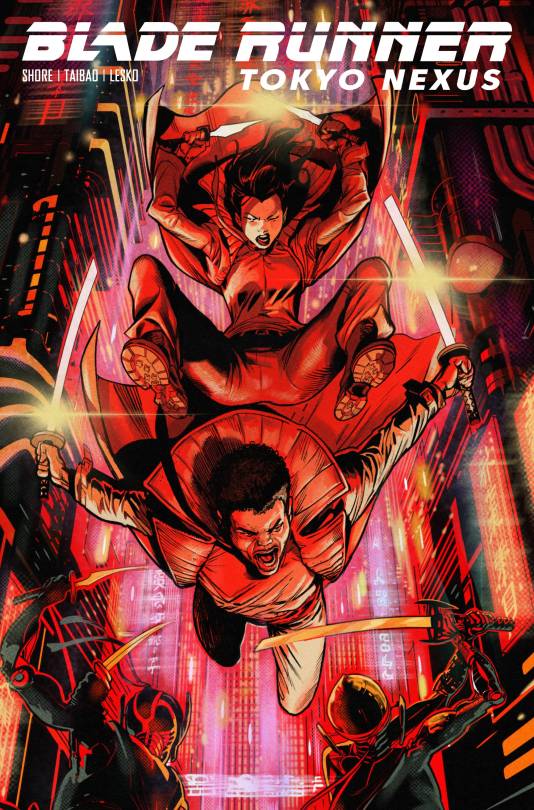
Blade Runner: Tokyo Nexus #1 by Kianna Shore, Mariano Taibo and Marco Lesko. Cover by Christian Ward. Variant covers by (2) Andy Belanger, (3) Taibo and (4) Fernando Dagnino. Out in July.
"THE ELECTRIFYING NEW BLADE RUNNER SERIES! Tokyo 2015: Two Kalanthia survivors fight for their lives in a world where Blade Runners are the least of their problems. Following a failed mission Off-World, the only two survivors of a combat squad, ex-marine Mead and Replicant combat model Stix, have returned to Tokyo to search for the traitor who left them to die. Now operating as an unofficial private detective agency, Stix and Mead find themselves caught up in a deadly Patent War between the Yakuza, the Tyrell Corporation and Cheshire, a rival corporation developing their own bootleg Replicant technology as they search for a missing woman."
#blade runner: tokyo nexus#blade runner#titan comics#kianna shore#mariano taibo#marco lesko#christian ward#andy belanger#fernando dagnino#variant cover#comics
22 notes
·
View notes
Text

Out this week: Blade Runner: Tokyo Nexus #1 (Titan Comics, $3.99): Kianna Shore and Mariano Taibo tell the story of an ex-marine and replicant combat model who were left to die on an off-world mission — and now they’ve come back to Earth to gain their revenge.
See what else is arriving at your local comic shop this week!
cover by Christian Ward
#titan comics#blade runner#blade runner: tokyo nexus#comic books#comics#new comic book day#ncbd#new comics day#comic covers#new comics#new comics wednesday#christian ward#kianna shore#mariano taibo
5 notes
·
View notes
Text
Preview: Dune: House Atreides Vol. 2
Dune: House Atreides Vol. 2 preview. The young Duke brings news of the revolt brewing on Ix, but the city's leaders make a decision that may threaten everyone #comics #comicbooks #dune
#boom studios#brian herbert#dev pramanki#dune#dune: house atreides#kevin j. anderson#mariano taibo#mike del mundo#trade paperback#trade paperbacks
0 notes
Text
Blade Runner Tokyo Nexus #1 Review
Blade Runner Tokyo Nexus #1 Review #BladeRunnerTokyoNexus #BladeRunner #TokyoNexus #Titans #TitansComics #reviews #previews #NCBD #comics #comicbooks #art #news #comicreviews
Writer: Kianna Shore Artist: Mariano Taibo Colorist: Marco Lesko Letterer: Jim Campbell Editor: David Leach Creative Consultant: Mellow Brown Cover Artists: Christian Ward; Andy Belanger; Mariano Taibo & Marco Lesko; Fernando Dagnino; Paul Pope & Lovern Kindzierski; Blank; Publisher: Titan Comics Price: $3.99 Release Date: July 31, 2024 Stix was supposed to meet Mead in a poor Tokyo district. But…
#Blade Runner#Blade Runner Tokyo Nexus#Blade Runner Tokyo Nexus 1#Blade Runner Tokyo Nexus 1 Review#Reviews#Titan#Titan Books#Titan Books Reviews#Titan Comics#Titan Comics Reviews#Titan Reviews
0 notes
Link
0 notes
Photo
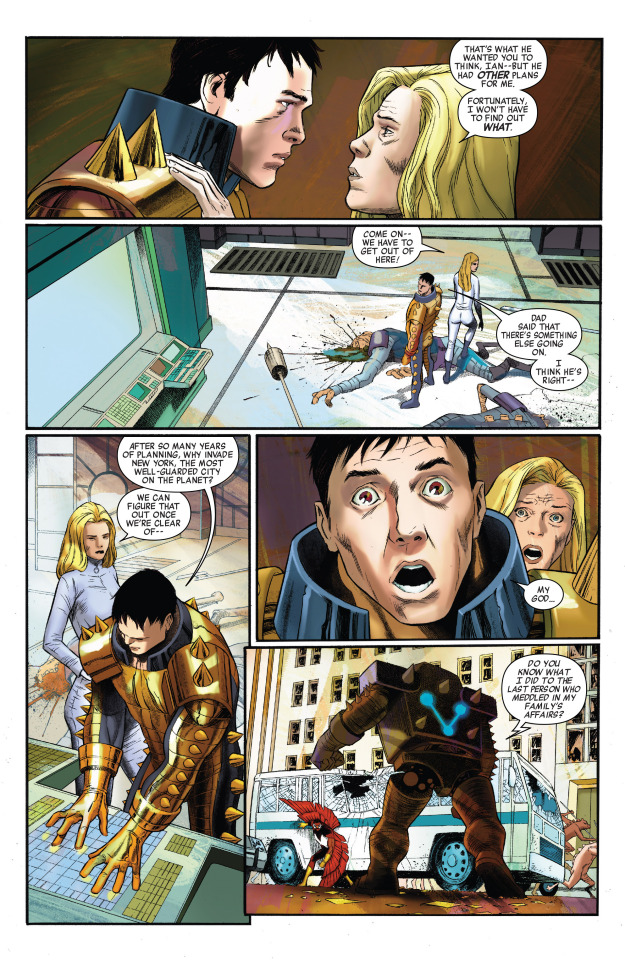
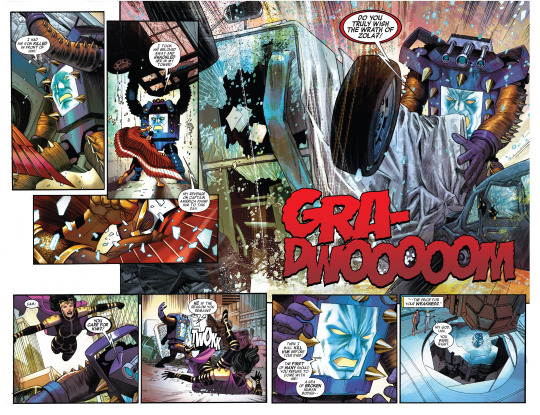
Sharon-A-Day, Day 284 (10/14/22)
Captain America V7 24. On sale 9/3/14.
Writer: Rick Remender
Penciller: Carlos Pachec
oInker: Mariano Taibo
Letterer: Joe Caramagna
Colorist: Dean White
Editor: Tom Brevoort
Sharon and Ian are reunited, but they still have a job to do.
#sharon carter#agent 13#captain america#steve rogers#ian rogers#the falcon imagine#sam wilson#rick remender#carlos pachec#mariano taibo#joe caramagna#dean white#tom brevoort
13 notes
·
View notes
Photo

AAROOOOOO
Dune: House Atreides #8 L: Ed Dukeshire A: Dev Pramanik I: Mariano Taibo C: Alex Guimaraes W: Brian Herbert & Kevin J. Anderson
#dune house atreides#dune#dev pramanik#lettering#typography#boom studios#ed dukeshire#mariano taibo#alex guimaraes#brian herbert#kevin j. anderson
3 notes
·
View notes
Text
First Look: Power, Lies, And Corruption In 'Dune: House Atreides' #9
First Look: Power, Lies, And Corruption In ‘Dune: House Atreides’ #9
BOOM! Studios has revealed a first look at Dune: House Atreides #9, adapted & scripted by Brian Herbert and Kevin J. Anderson, and illustrated by artists Dev Pramanik and Mariano Taibo, colorist Alex Guimarães, and letterer Ed Dukeshire. ‘Was foul play involved in Leto’s father’s untimely death? Follow the new Duke Atreides as he stops at nothing to find out. Power, lies, and corruption…

View On WordPress
#Alex Guimaraes#Boom! Studios#Brian Herbert#comics#Dev Pramanik#Dune: House Atreides#Ed Dukeshire#Kevin J. Anderson#Mariano Taibo#Previews
1 note
·
View note
Text

What are the mitts for? Is it easier to block magic spells if you’re wearing a special mitt? And the spells are just kind of glowy punches?
#The Magicians#lilah sturges#pius bak#mariano taibo#gabriel cassata#mike fiorentino#qistina khalidah#matthew levine#archaia
2 notes
·
View notes
Text

Mariano Taibo - Blade Runner
11 notes
·
View notes
Text
The Magicians #3

The Magicians #3 Archaia 2019 Written by Lilah Sturges Pencilled by Pius Bak Inked by Mariano Taibo Coloured by Gabriel Cassata Lettered by Mike Fiorentino After the shocking conclusion of the last issue, the five students chosen to learn battle magic are forced to confront the terrible consequences of what they’ve done, and what it could mean for the future of Brakebills. As tensions mount, the traditional Brakebills students and the newly admitted hedges begin to turn on one another. So this still has me incredibly excited. The only downside I see here is that there are two issues left and I want an ongoing monthly. Lilah's take on these students is a breath of fresh air and has actually reinvigorated my love of the franchise. This new Brakebills is what I want to read about these new students and what is going to happen after the reveal I want to follow. I mean seriously this is true badassery going on right here within these pages and the fact that it seems we are constantly being surprised at every single turn is exhilarating. I adore the way that this is being told. The story & plot development that we see through how the sequence of events unfold as well as how the reader learns information is really ingeniously laid down. How the circumstances and situations arise and how the kids deal with them is interesting and delightful. The character development that we see through all this and how they react to what is going on around them really shows us their true character. The way that we see them grow and evolve throughout the series has been magnificent to see. The pacing is superb and as it takes us through the pages revealing all the twists and turns along the way generates even more intrigue and suspense. All of these factored together create the ebb & flow of the book and showcase how it's structured. So the fact that Professor Warren and Headmaster Fogg know something is coming and have reopened the school for a very specific reason and what that may be we still don't know the full extent of is that perfect tension builder. The kids already know something is wrong and while they have to work things among themselves their respective teachers have their own plans for doing what they are doing and sooner or later the truth is gonna hit like a ton of bricks. The interiors are rather delightful. I would not mind seeing a bit more attention to detail here after all this is a world of magic and to see more attention paid to things like when Em goes running or walking past a window and it looks unfinished. Otherwise the utilisation of the page layouts and how we see the angles and perspective in the panels show a strong eye for storytelling. I like how the varying weights of the linework are utilised throughout as well. The colour work is alright here and the colour blocking utilises a few tones within the colours to bring a nice sense of shading. The cliffhanger ending here is one for the ages. It also helps to set the stage for the ultimate confrontation that no one is truly prepared for. More so with what is going to be some really interesting words to be said between Em and Audrey and boy I cannot wait for those fireworks, provided Em decides she's finally going to stand up for herself and let loose. Of course that could totally benefit her with her battle magic since she's gonna have the pent up anger and rage. No matter how ya slice it next issue is going to be that penultimate issue before the finale hits us.

#comic books#comics reviews#archaia#lilah sturges#pius bak#mariano taibo#gabriel cassata#mike fiorentino
0 notes
Text






Can’t Wait for Wednesday | Mighty Morphin Power Rangers face their ‘Darkest Hour’
Check out new comics and graphic novels arriving this week by Melissa Flores, Simona Di Gianfelice, Jed MacKay, Pepe Larraz, Guy Colwell, Kianna Shore, Mariano Taibo and more.
#comics#comic books#new comic book day#ncbd#new comics day#new comics#new comics wednesday#graphic novels
2 notes
·
View notes
Text
Preview: Magic Book 3
Magic Book 3 preview. In a time of relative peace, threats from the Planeswalkers' past refuse to rest. #comics #comicbooks #mtg #magicthegathering
#alberto locatelli#fabiana mascolo#french carlomagno#giorgio spalletta#hasbro#ig guara#jacques salamon#jed mackay#jorge coelho#kath lobo#magic#magic: the gathering#mairghread scott#mariano taibo#michael shelfer#miguel mercado#rich douek#roberta ingranata#trade paperback#trade paperbacks
0 notes
Text
Comics read this past week:
Marvel Comics:
Captain America (2013) #11-25
These issues were published across September 2013 to October 2014. All were written by Rick Remember. Issues #11-12 and #14-15 and #22-23 were penciled by Carlos Pancheco, with issues #11-12 being inked by Klaus Janson and issues #14-15 and #22-23 being inked by Mariano Taibo. Issues #13 and #17-21 were drawn by Nic Klein Issue #16 was drawn by Pascal Alixe. Issue #24 was penciled by Carlos Pacheco and Paul Renaud, and it was inked by Mariano Taibo and Paul Renaud. And issue #25 was penciled by Carlos Pacheco with Stuart Immonen, and it was inked by Mariano Taibo with Wade von Grawbadger.
I personally liked all of the art in this batch of issues better than John Romita Jr.’s art in the storyline that preceded it.
Issues #11 and #13-14 and #17-21 and #23 were colored by Dean White. Issue #12 was colored by Dead White and Rachelle Rosenberg. Issue #15 was colored by Rachelle Rosenberg with Rain Beredo and Val Staples. Issue #16 was colored by Edgar Delgado with Antonio Fabela and Israel Silva. Issue #22 was colored by Dean White with Lee Loughridge. Issue #24 was colored by Dean White and Sonia Oback. And issue #25 was colored by Marte Gracia, Dean White, and Veronica Gandini.
Issues #11 and #13-17 and #19 and #22-23 were 20 pages. Issues #12 and #20 and #24 were 21 pages. Issue #18 was 19 pages. Issue #21 was 24 pages. And issue #25 was 26 pages.
The first 10 issues of this series is a storyline that’s disconnected from the usual Captain America fare. I think sometimes that sort of thing can be invigorating for a long-published character, and other times it can be frustrating for readers there specifically for a story about a favored character because they don’t feel like that’s what they’re really getting. I had that latter reaction to Bucky Barnes: The Winter Soldier (2014). I wasn’t that into “Castaway in Dimension Z” in the beginning of the arc, and then at the very end I appreciated what it was doing for Steve’s character, but wasn’t convinced it needed to be as long as it was. In these issues I liked how Rick Remember wrote Steve in his usual setting, and I grew to appreciate more of what the entirety of the preceding arc did for Steve’s character.
I knew that this series was going to end with Sam becoming the next Captain America, and I don’t have any problem the concept, I thought the book was more building up to Ian taking over the role. He and Steve reunited in issue #23, and back in issue #4 Steve told Ian after he complained that about them using the shield instead a gun, “Total precision over brute force. A pistol doesn’t become a part of you the same way. It’s important you learn to use her. You’ll take it one day, when I’m gone-” But the final two issues really sold me on it being Sam.
I enjoyed Jet Black’s character and her arc throughout the book, and I was really disappointed by her ending. I think that she would leave everyone for Zola because she felt betrayed is a hard sell when she had developed strong ideological differences with Zola, but I know she also lost her anger for him over Ian’s death after learning to at Ian was still alive. I would like for Jet Black to later end up on the good side again. It’s pretty obvious to me, and it should have been obvious to Sam, that if she really was feeding information to Zola then it was because he had made her to do so unconsciously. But I think it’s understandable that Sam didn’t speak up for her better considering his injuries, and he seems to me to understand the truth at the end. I found Sharon’s rash actions deeply frustrating, but I think it makes sense given what she went through with being trapped in Dimension Z for years. I also think it’s in character for her considering her pattern of rash actions in Captain America (2011), which I attribute to her mental state because of what she went through in Captain America (2005) and her guilt over having played an unwitting role in Steve being lost in time for years.
I didn’t really like Jet Black’s relationship with Sam. Maybe I wasn’t paying proper attention to their few interactions, but it seemed to come out of nowhere to me. And I don’t think Jet Black would be that smooth in her first relationship, but this is Rick Remember’s creation that he’s writing. And I acknowledge that Jet Black’s relationship with Sam served a purpose in the end with having them all having a more immediate, personal stake in their final fight, and there being someone other than her father vying for her loyalty.
I know that the next series is about Sam with Steve as only a supporting character, and I believe that in that, and in any other comics he appears in, Ian will only minor character. So while I would really like to see more about Steve and Ian’s relationship, and to see some of Sharon and Ian’s relationship in Dimension Z, I’m not that hopeful for it.
In issue #21 Steve barely manages to stop the Iron Claw from using a massive weapon he stole from S.H.I.E.L.D. to wipe out a whole country, for which the United States would have been blamed and which would have started WWII. In issue #22 Steve is shocked to learn the, rather than destroying the remaining parts, S.H.I.E.L.D. is going to rebuild the weapon. Nick Fury Jr. tells Steve, “How insane is it to build something that we can use to protect ourselves the next time a celestial executioner shows up? Is it so crazy that we’d want to build something to protect ourselves from such threats? In case the super heroes ever fail? Some people in S.H.I.E.L.D. think it’s crazy for humanity to put all its faith in a self-appointed band of costumed adventures. All respect, Captain, you think S.H.I.E.L.D. got too big and overreached? Have you looked at the size of the Avengers roster lately?”
I found this argument deeply frustrating. Something that has the capacity to destroy the planet also has the capacity to destroy the planet itself, and it inherently poses a danger to what is around it to be used on, which is Earth. I don’t think even in the Marvel universe it’s justifiable to have it. I thought that a possible comprise would be to have the weapon be in pieces spread out around the planet, so that it would be harder and more time-consuming to steal the pieces from the people who gave control of the different parts, but that was never brought up. And I suspected that this weapon was going to be needed by the end of the book, to justify Nick and S.H.I.E.L.D.’s status quo, but that didn’t happened.
I also don’t think that S.H.I.E.L.D. and the Avengers are a reasonable comparison to make here, because I think with S.H.I.E.L.D.’s secrecy and advanced technology and amount of people and how it’s run, it has a lot more capacity to harm the planet; whereas with the amount of superheroes there are, they wouldn’t be united in harming the planet. I’m also confident that the public, who just saw millions of people nearly killed by this giant weapon, if they got a say in this, wouldn’t support it being rebuilt.
Right before that conversation we see Steve watching the news and a woman is questioning how S.H.I.E.L.D. is overseen and who Captain America answers to. I actually thought this was the most nuanced portrayal I’ve seen of the news media criticizing a superhero. In the Captain America (1968) issues past issue #600 and in Winter Soldier (2012) everything is very dismissive of the brief bits we see of the public criticizing Bucky for the crimes he committed as the Winter Soldier. And I thought the public criticism of Steve in Captain America (2012), where, for example in issue #15, “Captain America’s good deeds” were acknowledged, “But what has he done to save us from the rising unemployment rate? Escalating gas prices? The crashing economy?” None of that is what Captain America’s for. Overall I actually think the politics of this book are a lot more well-conceived than the politics of Captain America (2012). And I believe everything else I’ve seen of superheroes being criticized by the news has been of them having been framed.
While the woman speaking on the news is really angry, she’s able to make points I think are sound. For example, she says, “I think anybody who’s representing our nation to the entire world should be held accountable to the voters. They should be elected.” I think this is actually fair considering we see in this series how Steve’s actions can affect countries’ relations with the U.S. in a serious way. And I think Nick Jr.’s criticism that “It’s just some terrified people, angry because they don’t understand the entire story. Jumping to the worse possible conclusions about you. Everyone loves to assume those in charge are corrupt,” is really unfair. I think the public perception of events is reasonable considering what information they have, and it’s unreasonable to expect that they would just guess that things are fine without that being demonstrated to them.
In issue #11 we see that Steve’s home is filled with many, many nostalgic items. I’ve liked the idea of Steve being a sentimental person, but this depiction is the most extreme I’ve ever seen. Where he presumably spent causal free time looked like a museum. When Steve gives Jet Black the sage advice that “in order to grow, you must let go of the past,” she says to him, “Are you lecturing me about letting go of the past amidst your shrine to it?” At the end of the issue he piles everything outside and burns it all. To me this action clearly didn’t bode well for Steve mental state, and I appreciated that, later in issue #13, Sam said that “this is a sign of trouble.”
In issue #12 Steve thinks, over a scene of him drawing himself and Ian, “Everything here… It’s all so foreign. My friends are like strangers. Can’t let anyone know what I’ve been through. That I’m weak. And this city- this world- it’s not home. Home is another plane of existence. A place with two suns and barren purple deserts. The place I left my family. Where Sharon gave her life. It should have been my sacrifice that stopped Zola. I should still be there. With my son. The son Zola took. Because he knew. Knew even if I survived… I’d die with Ian.”
And Steve tells Sam, “Before I left, Sharon said something. Told me I’m frozen in the past. An assessment more apt now than before. This place was a lifetime ago. How can I be strong, stand up and serve… if I can’t let go of what happened?” And he says, “I’m lost here. Struggling to find meaning… in a world that holds none for me.”
Steve’s narration over part of a fight scene with Nuke in issue #14 reads, “Nothing slows him down. And my control is fading. Something’s unleashing itself. Something caged inside me- something furious. Some new rage. Born of grief. My mind in another place. With my dead family. Rage makes me sloppy. Rage isn’t the solution to this- intellect might be.” Later in the issue Steve tries to kill Nuke, but Sam stops him.
In issue #15 Steve tells Nuke, “The war is over, son. And it’s time to come home from it. I know how frightening that can be to hear. It means you have to come back. It means you have to rejoin a world that is in no war familiar to you. To smile and pretend that everything is normal. But in order to grow you must let go of the past.”
In issue #17 Jet Black brings up how Steve’s reputation has recently been “tarnished” and says, “I know that is something you care deeply about.” He tells her, “I’m a representative of my people. It’s important I embody a high standard.”
They then talk about Steve’s stance against “Execution without a trial” and how Jet Black’s Zola-informed worldview means she thinks Steve should have killed Nuke. After they pass a banker having an absurdly immoral conversation on the phone, Steve says, “Maybe the Punisher is into something. Couldn’t hurt to darken up the image some.” Steve ends up saving that banker from the Communist villain’s henchmen, and afterwards when the banker tries to offer Steve a reward for saving his life, Steve is clearly frustrated and disgusted with the situation.
In issue #18 Steve jokes to Sam as he steals a motorcycle during a fight scene, “Gonna borrow the bike. Left mine at home.” Then he thinks, “Home. Wherever that is. Lower East Side with Mom. The red mountains of another reality- Teaching my son. Living simple. I was happy there. The threats were apparent- they didn’t hide behind the smiles of allies.” This is after S.H.I.E.L.D. acted suspiciously.
In issue #19 Steve thinks, after seeing a lot of people die, “Fallen to weakness in the days since returning to Dimension Z. Any self-recrimination always replaced by the image of my son and fiancé. Any man would fall apart. But I’m not any man. I’m Captain America. I’m held to a higher standard. No matter my sorrow or loss- I always stand up. Hundreds of dead S.H.I.E.L.S. agents. Dead because I let Nuke live. Get the man responsible for this. Jet had the right of it. This is on my head… and I won’t make the same mistake twice.”
In issue #20 Steve was trapped in an illusion that shows you a perfect life before turning on you and killing you, and the only way to escape it is to kill yourself before it kills you, which Steve does. In the moment of darkness before the illusion started, Steve thought, “What if some wars are unwinnable? What if the better choice wasn’t to stand up… but to walk away? Dear God, I can’t do this anymore. I’m lost here. My heart still on those orange hills with my son. I suit up, put on a strong face… but underneath I’m disappearing. I keep fighting on instinct. Because it’s all I know. Standing against an endless current, barely slowing the erosion. Mom, Ian, and Sharon… those closest to me are gone. How can any man face an endless war… with no family to fight for?”
In issue #21, during a fight, Steve thinks, “Never been a point in any battle I’ve fought that I felt so vacant… so hopeless. Asleep at the wheel since Dimension Z. All of this happened under my nose. Nuke, all the signs were there- someone was manipulating him- someone was setting a trap. I was a million miles away- with Sharon and Ian. So focused on what I lost- I’m losing all I have.” And then later, “[O]nly one thing matters- do your duty. I stayed down for too long- let them beat me. Let it all go too far. Forgot- I’m not Captain America. I’m just a man who wears the suit- a sacred privilege.”
And in issue #25, as Steve is introducing Sam as the next Captain America, he calls him, “A man whom I love with all my heart,” which I really liked.
Iron Man (1968) Annuals #3 and #4
These issues were published in March 1976 and May 1977, respectively. Annual #3 was written by Steve Gerber, penciled by Sal Buscema, and inked by Jack Abel. It was 35 pages. Annual #4 was written by Bill Mantlo, penciled by George Tuska, and inked by Don Perlin. It was 29 pages.
The plot of Annual #3 happens because the Thing (of the Fantastic Four) in another issue gifted a child with the wand of the believed-dead villain Molecule Man. This ends up allowing Molecule Man to possess the body of one of the kid’s friends. It didn’t seem to have powers when the kids were playing with it, but giving the weapon of a villain to a child seems pretty reckless of Ben.
The citizens of Citrusville react negatively to Iron Man fighting above their town. The assumption is made that Tony Stark, who was visiting the area because of a project he was funding, must have known that there would be danger there. Tony argues as Iron Man that he merely accompanies Mr. Stark everywhere as his bodyguard. But in response to his attempt to defuse the situation, he’s told, “He talks jes’ like o’ them press secretaries,” and “We know what kinda grief follows you super-types arou[nd].” I believe this is the first time Iron Man has ever experienced that kind of reaction from civilians. I was surprised that this was afterwards attributed to the town being “conservative,” and that it was thought relevant that there had previously been “book-burnings” there and “undercurrents of suspicion and mistrust” remained in their local culture. Also, in this issue Tony is funding a “solar power” project which could “offend the oil interests.” And the person he’s working with says to him, of the townspeople, “The world is changing, Mr. Stark- and because we’re agents of change, we’re anathema to these people.”
Right before Tony uses a screen inside to contact the Avengers, he says, “I’ll avail myself- of the reason I had this limo flown with me to Florida: my direct hookup to- Avengers Mansion.” I believe this is the first time we’ve seen that Tony has convenient technology like that around him.
I liked this narration towards the end of the story, just before everything went wrong again, which read, “All in all, a rather satisfying way to end this tale- save that neither the exigencies of comic book publishing nor existential circumstances will allow us so tidy a conclusion. We’ve still four pages to fill.”
When Iron Man fought Molecule Man, the villain struggled to maintain control the body of the child he possessed. Tony called him “the only villain I’ve ever tackled that was more interested in fighting himself than [me].” Then when Molecule Man possesses him, Tony says, “[W]on’t let my muscles work- trying to keep my mind from functioning, too- but you can’t do it, Molecule Man- You can’t! You could barely win dominion over the mind of a little girl!” And Molecule Man tells him, “I can wait, Avenger- take my time- exert only enough effort to strain Anthony Stark’s damaged heart to its limit! Then, when you’re impotent to prevent it- I’ll take you, Iron Man!”
The narration describes, “If Anthony Stark’s armor were merely a veneer of iron, there would be little to term heroic about its wearer. But its significance goes deeper… to a will of iron, a sense of self, and so tenacious a grasp on the principle of the individual’s essential dignity and worth, that despite the pain knifing his chest, he battles the Molecule Man to a standoff. No human could do more… or maintain such concentration for long.”
In Annual #4, after he realizes that M.O.D.O.K. has a weapon of incredible power, Tony says, “It’s too late to contact the Avengers, but two ex-Avengers are already here on the coast! The Black Widow and Hercules! Part of a new super-group- the Champions!”
After Tony explains everything, Natasha says, “It’s never easy is it, old friend?” And Tony tells her, “No, Widow, it’s not!” I enjoy their comradery.
I was also interested in a moment where Warren Worthington III, the Angel, announces that he’s going to scout ahead for a place for the team’s plane to land, then thinks, “Had to get away from the others! It’s so seldom I can just be alone- to spread my wings and… fly! Times like this it doesn’t matter that I’m a mutant, that I’m different!” I was surprised by Warren’s desperation here. I’m assuming this is his first time being on a team that’s not the X-Men, where he would have been surrounded by only mutants. Though he’s not the only mutant on the Champions as Bobby Drake, Ice-Man, is also there. He is the only main member of the Champions that can fly, however. I wouldn’t think that he would be by himself more often when he was at a boarding school. Perhaps it’s specifically that he doesn’t get as much time to fly off-mission, which is important to both his comfort and mutant identity, and that he inherently feels different and ostracized outside of the familiar environment of being around only mutants. Also, I did notice that later in the issue one of the A.I.M. goons says to Warren, after knocking out one of his teammates, “And you’re next, mutant!”
One of the villains declares, “I am… Stryke! Created to serve Modok- but I also enjoy what I am ordered to do!” I imagine this makes maintaining loyalty easier.
I hadn’t categorized them this way, but the Champions split up to search separate areas, and later Hercules asks, “How fare our younger teammates?” The groups were Black Widow, Hercules, and Angel, and then Ghost Rider, Darkstar, and Ice-Man. I did notice there was strong coordination amongst that first group, while there was some petty insults on Ghost Rider’s part directed towards Ice-Man in the second group. And it was also only that first group that fully succeeded without anyone getting injured. I believe the age breakdown is two adults and one young adult/teenager in the first group, and three young adults/teenagers in the second group.
I also really liked a scene where a mountain collapsed on the Champions and Hercules protected the team by holding up a large piece of rubble that shielded them until someone else could break them free. And he reassured Bobby, who was worried about the rubble giving way “That it will not do, lad, whilst Hercules braces it with his own body!” The scene reminded me of the part of The Avengers (1963) #42 where Hercules postures that he really wants to fight a villain, but really he was worried about the Wasp, who being held hostage, and wanted to be the one to ensure she was safe. I enjoy when he uses his immense strength to protect others. That sort of thing appeals to me more than admiring characters for how well they beat someone up.
At the end of the issue Tony thinks, “Have to set down at Stark-West in L.A.- to rest and recharge! And while I’m at it, maybe I’ll do something nice and leisurely- like inspect my factory, say hello to my employees! The things I’m paid to do!” I thought this was cute.
DC Comics:
Nathanial Dusk II (1985) #1-4
These issues were published across July 1985 to October 1985. All were written by Don McGregor, penciled by Gene Colan, and colored by Tom Ziuko. The artwork was not inked. Issue #1 was 44 pages, and the rest were 48 pages.
I realized when writing out what I’ve read before that was drawn by Gene Colan for a previous comics round-up that I never read this follow-up to Nathanial Dusk (1984). I’ll also say that I forgot to mention before that Gene Colan penciled black-and-white stories in Hulk! (1978) #24-27. And I believe the only thing I’ve ever read before that was written by Don McGregor is the miniseries that preceded this one. I should look up his other work as it’s very impressive here.
This is a mystery story, starring a private detective, that takes place in 1934. The strength of the book is less so in the mystery in my opinion and more so in how it’s grounded in the era of the 30s and the perspective of its well-conceived main character, though there’s nothing to fault with the plotting. The book has a good connection to the first one with some characters carrying over, in particular the two young children of Joyce, Nathanial’s love interest who was killed in the first book, as Nate struggles in his relationship with her son. Finishing this book made me wish there had been more Nathanial Dusk comics, but I appreciate the hopeful tone of the final scene. Very well done and I would strongly recommend both miniseries.
I don’t remember if this was a prominent theme in the first book, but throughout this miniseries the character has to repeatedly grapple with his fear of dying when he nearly does, and I really enjoyed the writing of those parts of the narration in particular. That’s followed in issue #3 with Nathanial turning down money that would make his life easier, including not having to do this dangerous work, because he thinks, “Take it, and you’re dead, another voice said. Take it and everything you ever stood for will begin to die, right this moment, before you even leave the room!” I also really liked Nathanial’s grief for Joyce throughout the book.
The artwork was great as expected. I particularly enjoyed the panels in which Nathanial or the woman who hired him, Amanda, looked fashionable just because that appeals to my personal taste. The only problem was that I didn’t always think the facial expressions described in the narration were what the art conveyed.
Batman (2016) #38
This issue was published in January 2018. It was written by Tom King, drawn by Travis Moore, colored by Giulia Brusco. It was 20 pages.
This issue was about a rich kid in Gotham who had his parents murdered because he admired Bruce Wayne and wanted to be like him. The kid’s speech at the end is about how he has uniquely suffered in a way that others can’t understand, that the deaths of his parents is a terrible pain that will be a part of him forever, but that being scared “Just means you get a chance to be brave.” That quote is something that Bruce had said as Batman earlier in this run, in a flashback in issue #3, to Gotham after Bruce had saved him and his parents during a mugging attempt. This is what inspired Gotham and his sister to become superheroes, and Bruce became hopeful that they could save the city with their dedication and powers, but then Gotham ended up mentally cracking due to a traumatic experience being a superhero brought him to, and he died in issue #5. Bruce said that quote again earlier in this issue as Bruce Wayne to the recently-orphaned kid before he’d figured out what really happened.
The sick, rich kid then declares, “My parents died for this city! I watched them die!” And, “I’m Master Bruce, and I will never stop fighting for the light!” The issue ends with the kid being told he’s not Bruce Wayne, only “a sick kid with dead parents,” and him responding, “But what else is Bruce Wayne?” I think that this being the final dialogue of the story unduly emphasizes the concept of defining Bruce that way, when I think the real purpose of the story is adding another angle to the run’s critical view of how Bruce motivates himself with/by his trauma and justifies that. For example, earlier, in issue #12, Bruce’s initial decision to become Batman was said to have occurred at the same moment as self harm, and his vow “by the spirits of my parents to avenge their deaths by spending the rest of my life warring on all criminals” was framed as a suicide pact.
Also, I believe the idea that “[Batman is] sick. The freaks are sick. Gotham is sick. Master Bruce is the cure!” and that, the kid believes, as Bruce Wayne, “I help others. I am inspired by my parents to save everyone,” runs counter to the typical view of the character, which focuses on the Batman side of how he helps, that Batman is the cure both for the city and (is at the very least the reprieve) for Bruce’s personal problems. I may be wrong about how Batman fans view Bruce being Batman as I’m not involved in those fan spaces, but I think the emphasis on that Bruce being Batman was unhealthy for him was one of the things that made this run controversial.
Image Comics:
Local Man (2023) #5
This issue was published in June 2023. It was written by Tony Fleecs and Tim Seeley. The main story, which was 26 pages, was drawn by Tony Fleecs and colored by Brad Simpson. And the back-up story, which was 6 pages, was drawn by Tim Seeley and colored by Felipe Sobreiro.
I have to say I think the plotting of this book is really well done. The issues are engaging. There have been so many surprise reveals in only 5 issues, which I think can be really hard to do well and not seem forced or cheap, but so far it’s all worked for me and come across as that the book is well-planned. The first twist I felt iffy instead of excited about was the reveal at the very end of the main story in this issue, and then the back-up story got me on board with it.
0 notes
Text
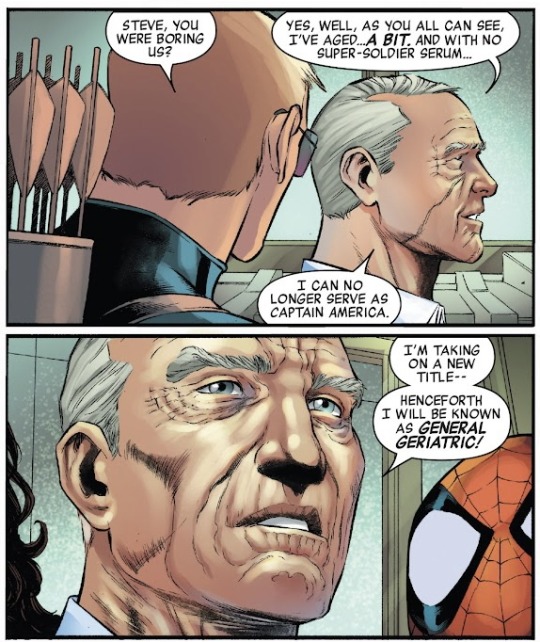
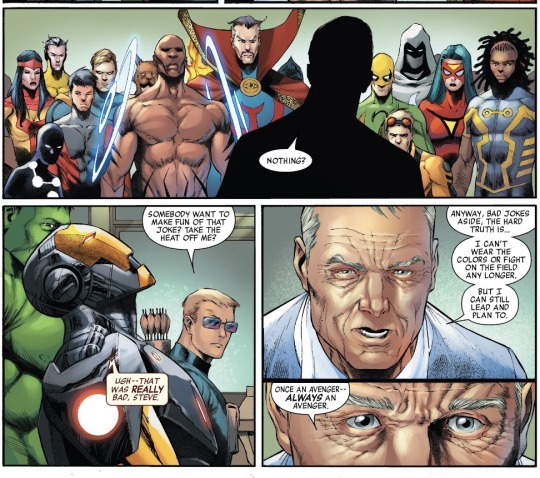
“The Tomorrow Soldier: Conclusion” Captain America (Vol. 7/2013), #25.
Writer: Rick Remender; Penciler: Carlos Pacheco; Inkers: Mariano Taibo and Paul Renaud; Colorists: Dean White and Sonia Oback; Letterer: Joe Caramagna
#Marvel#Marvel comics#Marvel 616#Captain America vol. 7#Captain America 2013#Moon Knight comics#where’s moony#Moon Knight#Marc Spector#…Steve…please#but yeah Marc was present at Sam Wilson’s debut as Captain America so that’s cool
5 notes
·
View notes